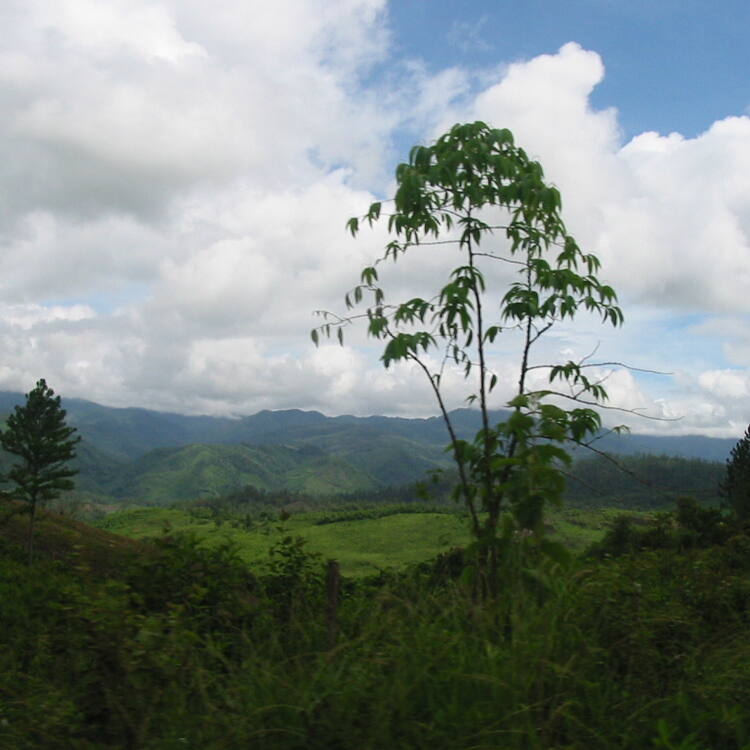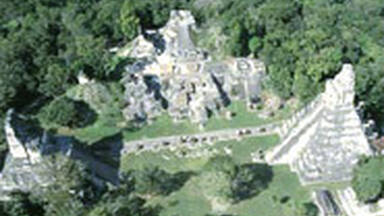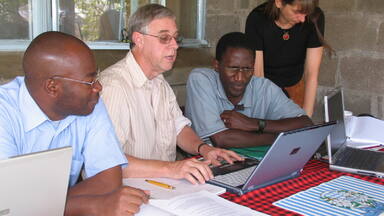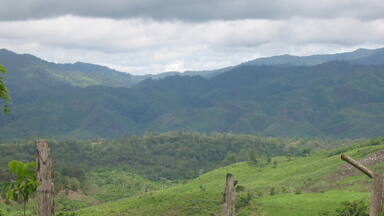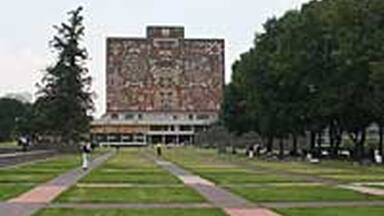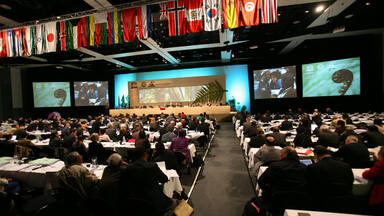Río Plátano Biosphere Reserve
Río Plátano Biosphere Reserve
Located on the watershed of the Río Plátano, the reserve is one of the few remains of a tropical rainforest in Central America and has an abundant and varied plant and wildlife. In its mountainous landscape sloping down to the Caribbean coast, over 2,000 indigenous people have preserved their traditional way of life.
Description is available under license CC-BY-SA IGO 3.0
Réserve de la biosphère Río Plátano
Située dans le bassin versant du Río Platano, la réserve abrite l'un des rares vestiges de la forêt tropicale humide d'Amérique centrale. Sa faune et sa flore sont abondantes et variées. Dans un paysage montagneux qui descend jusqu'à la côte des Caraïbes, plus de 2 000 indigènes ont conservé leur mode de vie traditionnel.
Description is available under license CC-BY-SA IGO 3.0
محمية المحيط الحيوي لريو بلاتانو
تشمل المحمية الواقعة في الحوض المنحدر لريو بلاتانو إحدى أكثر الآثار ندرةً في الغابة الاستوائية الرطبة لأميركا الوسطى.ويشهد للثروة الحيوانية والنباتية في هذه المحميّة بوفرتها وتنوعها. وقد حافظ أكثر من ألفي نسمة من السكان الأصليين على نمط حياتهم التقليدي في هذا الموقع الجبلي المنحدر حتى ساحل جزر الكاريبي.
source: UNESCO/CPE
Description is available under license CC-BY-SA IGO 3.0
雷奥普拉塔诺生物圈保留地
该保留地位于雷奥普拉塔诺河的分水岭处,是中美洲少数几个湿热带雨林保护区之一。保留地内有数量丰富、种类繁多的植物和野生动物。在它加勒比海岸延伸的山地上,居住有2000多名土著居民,他们仍然沿袭传统的生活方式。
source: UNESCO/CPE
Description is available under license CC-BY-SA IGO 3.0
Биосферный резерват Рио-Платано
Резерват, охватывающий водосборный бассейн реки Рио-Платано, включает один из немногих уцелевших в Центральной Америке массивов влажно-тропического леса, и выделяется богатой и разнообразной флорой и фауной. В этой гористой местности, понижающейся по мере приближения к побережью Карибского моря, проживают, сохраняя свой традиционный уклад, свыше 2 тыс. аборигенов.
source: UNESCO/CPE
Description is available under license CC-BY-SA IGO 3.0
Reserva de biosfera de Río Plátano
Ubicada en la cuenca del río Plátano, esta reserva alberga uno de los escasos vestigios de bosque lluvioso tropical de Centroamérica. Su fauna y flora son abundantes y variadas. En su territorio montañoso, que desciende en pendiente hasta la costa del Caribe, viven más de 2.000 indígenas que han conservado su modo de vida tradicional.
source: UNESCO/CPE
Description is available under license CC-BY-SA IGO 3.0
リオ・プラタノ生物圏保護区
ホンジュラス北東部のプラタノ川流域に広がる生物圏保護区。低地のラグーン、マングローブ、サバンナなどと、1000m前後の広大な山地といった変化に富んだ自然環境が見られる。現在、プラタノ川の源流域では、道路建設とそれに伴う森林伐採や不法な開拓などが行われ、「危機にさらされている世界遺産リスト」に登録されている。source: NFUAJ
Biosfeerreservaat Río Plátano
Dit reservaat ligt op de waterscheiding van de Río Plátano. Het biosfeerreservaat is een van de weinige overblijfselen van een tropisch regenwoud in Midden-Amerika. Het gebied heeft een overvloedige en gevarieerde flora en fauna. In het bergachtige landschap, dat afloopt naar de Caribische kust, hebben meer dan 2.000 inheemse indianen hun traditionele manier van leven behouden. In het reservaat Río Plátano leven 39 soorten zoogdieren, 377 vogelsoorten en 126 reptielen en amfibieën. Bedreigde soorten die er voorkomen zijn onder meer de reuzenmiereneter, Baird’s tapir, jaguar, ocelot, poema, margay, Midden-Amerikaanse otter, zeekoe, Amerikaanse krokodil, bruine kaaiman, arend, ara en gier.
Source: unesco.nl
Outstanding Universal Value
Brief Synthesis
Located in the Mosquitia region of Northeastern Honduras, Río Plátano Biosphere Reserve is the largest protected area in the country with 350,000 hectares. The property protects the entire watershed of the Río Plátano all the way from the headwaters in the mountains to the river mouth on the Caribbean Coast. Adding to its importance, the property is an integral part of a significantly larger conservation complex encompassing Tawahka Asangni Biosphere Reserve and Patuca National Park, among other protected areas. Taken as a whole, the conservation complex in Northeastern Honduras is contiguous with Bosawas Biosphere Reserve in neighbouring Nicaragua, jointly constituting the largest contiguous forest area in Latin America north of the Amazon. Besides the remarkable dense rainforests in the mountains, there is a highly diverse array of distinct ecosystems in the coastal lowlands, including wetlands, savannah and coastal lagoons. Recognised as a nature conservation gem, the property also harbours notable archaeological and cultural values, with numerous Pre-Columbian sites and petroglyphs, as well as the living cultures of the various local and indigenous communities. Indigenous peoples and peoples of African descent in and around Río Plátano include the Pech, Tawahka, Miskito and Garífuna, living alongside the Mestizo (Ladino) population.
The property boasts an extraordinary diversity of ecosystems and species. For example, 586 species of vascular plants have been reported in the low lands of the reserve. The over 721 species of vertebrates comprise more than half of all mammals known to occur in Honduras and include the critically endangered Mexican Spider Monkey, the endangered Central American Tapir, the vulnerable Giant Anteater and West Indian Manatee, as well as the near-threatened Jaguar and White-lipped Peccary. The endangered Great Green Macaw, the vulnerable Great Curassow and the near-threatened Guiana Crested Eagle and harpy eagle stand out among the impressive 411 documented species of birds. Taken together, reptiles and amphibians total about 108 species, with several species of poisonous snakes and 4 species marine turtles (Loggerhead, Leatherback, green turtle and hawksbill turtle) . Freshwater fish include the economically important migratory Bobo Mullet or Cuyamel.
Criterion (vii): The natural beauty of Río Plátano Biosphere Reserve is a function of the variety of the terrain and landscape types and features. Within its boundaries, the property harbours densely forested mountains reaching 1,418 m.a.s.l. at Punta Piedra, transitioning into savannahs, patches of pine forest and vast wetlands towards the coastal plains of the Caribbean Sea. Along the coast, there are spectacular lagoons, namely Laguna Brus and Laguna Ibans, both full of wildlife, boasting major bird colonies and serving as nurseries for fish and many other forms of aquatic life. Another characteristic element of the landscape are the many rivers and creeks, namely the eponymous Río Plátano and the Sico, Sikre Kipahni, Uhra and Tilasunta Rivers.
Criterion (viii): The property comprises two main geomorphological areas. These are the steep mountain range harbouring the headwaters of Río Plátano and the flat to undulating coastal plains. The latter is composed of terraces of recent marine sediments and partly underlain by a belt of infertile deeply weathered Pleistocene quartz sandy gravels. The Río Plátano meanders for some 45 kilometres through the lowlands forming ox-bow lakes, backwater swamps and natural levees. At about 100 m.a.s.l inland the foothills begin abruptly. The rugged granite mountains, which rise to Punta Piedra at 1,418 m.a.s.l. have many steep ridges, remarkable rock formations such as Pico Dama, a 150 metre pinnacle, and many waterfalls, one reaching 150 metres in height. Two thirds of the Plátano River run through a rugged part of the mountains with long stretches of white water. In one cataract in a deep forested gorge the river disappears under massive boulders. The mountains are part of the Cordillera Central, which corresponds to what was the Honduras Intercontinental Depression, during the Cretaceous period.
Criterion (ix): As one of a quickly decreasing number of major river basins the Plátano River, the heart of the property, continues to flow freely from its mountainous headwaters to the Sea. Along the altitudinal range the property connects a huge variety of very different ecosystems and habitats. The ecological linkages between these ecosystems and corresponding processes continue to be largely intact at the landscape level. Starting from the Caribbean Sea, there are estuarine and marine systems, sandy beaches, coastal lagoons of varying salinity, mangrove swamps, and pine savannah. Along the many rivers and creeks, there are broadleaf gallery forest traversing the savannahs and serving as natural corridors. The bulk of the property, however, are dense tropical rainforests covering the mountain ranges inland with smaller areas of rare elfin forest on the highest ridges.
Criterion (x): As a globally important stronghold of biodiversity Río Plátano harbours at least 586 species of vascular plants in its diverse habitats and there may still be species new to science in remote parts of the property. Across virtually all taxonomic groups, Río Plátano Biosphere Reserve is home to impressive proportions of the fauna of the entire country, in many cases well over half of the number of species occurring. The over 721 species of vertebrates include more than half of all mammals known in Honduras, such as the critically endangered Mexican Spider Monkey, the endangered Central American Tapir, the vulnerable Giant Anteater and the West Indian Manatee, as well as the near-threatened Jaguar and White-lipped Peccary. Other charismatic species are Puma, Ocelot, Jaguarundi and Margay, Neotropical Otter, White-throated Capuchin Monkey and Mantled Howler Monkey. The endangered Great Green Macaw, the vulnerable Great Curassow and Scarlet Macaw and the near-threatened Guiana Crested Eagle and harpy eagle stand out among the impressive 411 documented species of birds, along with Jabiru, King Vulture and the majestic Harpy Eagle. The 108 species of reptiles and amphibians comprise several rare poisonous snakes and 4 species marine turtles (Loggerhead, Leatherback, green turtle and hawksbill turtle)
Integrity
The Reserve contains a rich variety of ecosystems (28 terrestrial ecosystems and 5 coastal marine), habitats and species of global conservation importance. The Plátano River is a major landscape feature and corridor connecting all the landscape elements from the rugged mountains to the coastal plains. Granting a conservation status to the entire watershed from the headwaters to the river mouth is an ideal set-up from a conservation perspective.
Protection and Management requirements
Due to its archaeological importance parts of the Río Plátano basin became subject to protection efforts long before the nature conservation values were formally recognised. In 1960, Ciudad Blanca Archaeological Reserve was created, later re-classified as an Archaeological National Park in 1969, which Río Plátano formally remains to this day. In terms of nature conservation, Río Plátano Biosphere Reserve was originally designated in 1980 by Decree and substantially extended in 1997 by a further Decree. Likewise in 1980, the area was internationally recognized as a biosphere reserve, prior to the inscription on the World Heritage List in 1982. The legal umbrella for all formally protected areas in Honduras is the national General Environmental Law, which establishes the national protected areas system. Further regulations are specified in a corresponding by-law. More recently, the Forest, Protected Areas and Wildlife Law came into force, jointly with the establishment of a new governmental authority for the management and conservation of forests, nature and wildlife. The legal framework supports co-management agreements and involvement of civil society at all levels.
A major management instrument is zonation to distinguish areas requiring strict protection and areas of controlled use of natural resources.
Despite the strong legal protection, Río Plátano Biosphere Reserve has long been suffering from human pressure threatening its integrity. Forests continue to be logged and converted to pasture, agricultural encroachment and illegal resource extraction are widespread. While systematic law enforcement is needed, there is a consensus that addressing the complex environmental challenges requires integrated development strategies, policies and measures for the entire region across sectors and disciplines and involving local communities. The property is located in a remote region of rural poverty, where a balance between conservation and development is needed. Regulation of land tenure and access to resources and effective co-management and sharing of power in decision-making are seen as promising instruments to this effect.
Indigenous peoples in the Mosquitia continue to have a close relationship with their natural environment, as expressed in myths and beliefs but also knowledge and practices. While not a guarantee for sustainable resource use, this can make a valuable contribution to conservation. Ambitious plans for hydroelectric development on nearby rivers may also entail risks for the conservation values and local livelihoods, therefore requiring careful analysis. Future management of Río Plátano Biosphere Reserve should also promote an enhanced understanding and protection of the many archaeological sites hidden in the dense forests.
